I was just talking to some folks about data center site selection and the method to create a long list of criteria, create weightings, multiple the numbers, add the scores, then select the highest score as criteria site selection is flawed.
The flaw? Thinking that the weightings are the right numbers and the criteria can be counted as independent factors.
First one, weightings help prioritize those factors that are more important to the business. This creates a single number. Problem is business changes, and not all businesses can be represented by a single number.
Right approach, data center sites should be characterized by a range of performance that support the range of business now and in the future. The sites that should be scored highest are the ones that best suit the range of performance for the business, not the highest score.
The error of a single number view vs. the range can be illustrated by the "Flaw of Averages."
The Flaw of Averages
A common cause of bad planning is an error Dr. Savage calls the Flaw of Averages which may be stated as follows: plans based on average assumptions are wrong on average.As a sobering example, consider the state of a drunk, wandering around on a busy highway. His average position is the centerline, so...
Second one. The criteria listed are assumed to be independent factors, but most criteria have relationships to other things, and the interaction of criteria creates good and bad conditions that experienced people know, but the site selection so-called gurus think they can solve the problem with enough criteria and weightings.
For the amount of money spent on data centers over the lifecycles, data center models should be built. The trouble is few companies know how to do this as it requires a holistic view,bridging site, data center building, IT hardware, and software. This is problem worth solving.
